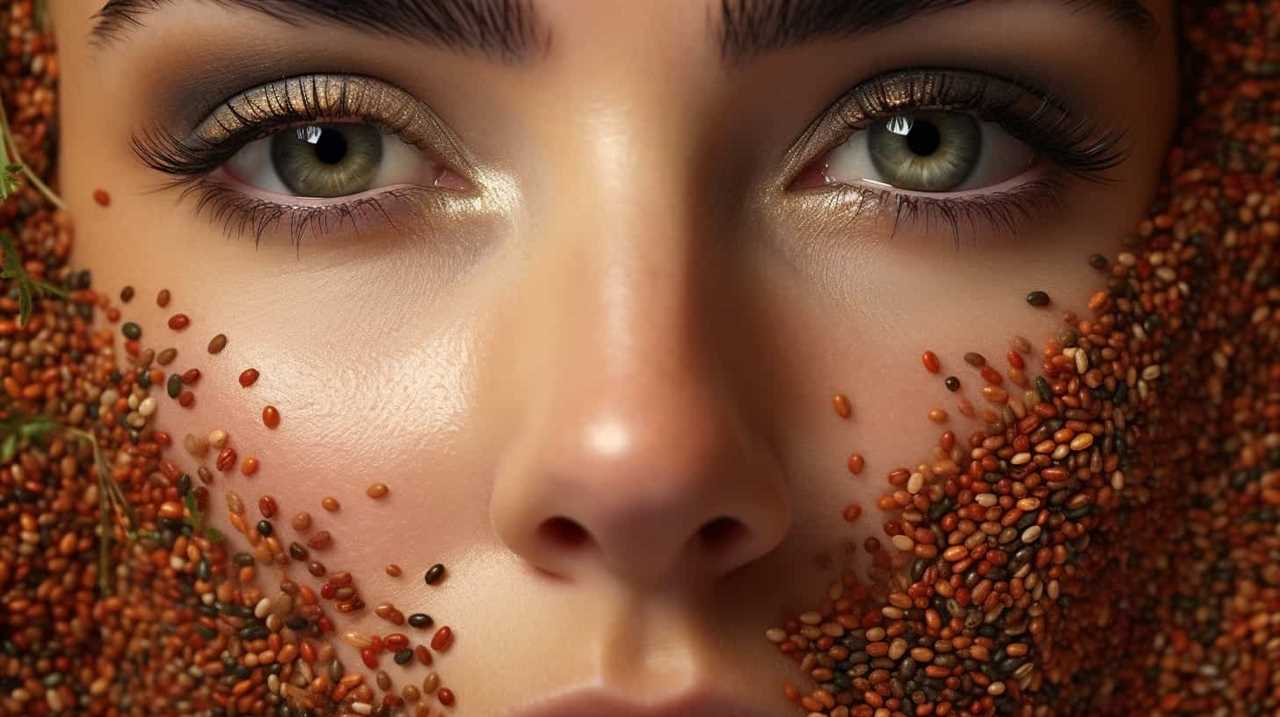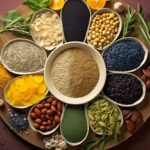Discovering the rich history of agricultural practices, we uncover the remarkable origins and enduring significance of nutritious seeds.
In this article, we trace the roots of these seeds, focusing on the captivating story of chia seeds.
From their ancient origins to their role in both Mesoamerican farming and early American agriculture, we explore how chia seeds have evolved into a staple crop.
Join us as we embark on a journey that unveils the fascinating revival of these remarkable seeds.

Key Takeaways
- Chia seeds have ancient origins in early agricultural practices and were considered a staple food in civilizations such as the Aztecs and Mayans.
- Chia seeds have significant cultural and religious significance in Mesoamerican society and were used for medicinal purposes.
- Chia seeds are packed with essential nutrients and provide various health benefits such as promoting heart health, supporting digestion, and regulating blood sugar levels.
- Chia seeds are versatile and can be used in various culinary applications, such as an egg substitute, thickening agent, or ingredient in smoothies and puddings.
Ancient Origins of Chia Seeds
Chia seeds have ancient origins that can be traced back to early agricultural practices. These tiny seeds hold a significant place in various ancient cultures, where they were highly valued for their nutritional benefits and sacred significance.
In civilizations such as the Aztecs and Mayans, chia seeds were considered a staple food due to their rich nutrient profile, which includes high amounts of fiber, omega-3 fatty acids, and antioxidants. These ancient cultures recognized the importance of chia seeds in promoting overall health and vitality.
Not only were chia seeds consumed as a source of sustenance, but they were also used for medicinal purposes, providing relief for ailments such as joint pain and digestive issues.
Today, we can still appreciate the ancient cultural significance and nutritional benefits of chia seeds, incorporating them into our diets for their nourishing properties.

Chia Seeds in Early American Agriculture
During our exploration of the agricultural roots of nutritive seeds, we encountered the role that chia seeds played in early American agriculture. Chia seeds were cultivated by Native American tribes, such as the Aztecs and the Mayans, long before the arrival of European settlers. They recognized the nutritional benefits of these tiny seeds, which were packed with protein, fiber, and omega-3 fatty acids. In fact, chia seeds were considered a staple food in their diets, providing them with sustainable energy and essential nutrients.
Early American farmers understood the value of chia seeds and began incorporating them into their own agricultural practices. They recognized the resilience and adaptability of chia plants, as well as the nutritional value of the seeds they produced. This laid the foundation for chia seeds to become an important part of American agriculture.
Transitioning into the subsequent section about chia seeds in Mesoamerican farming, let’s delve deeper into their cultivation techniques and the cultural significance attached to these remarkable seeds.
Chia Seeds in Mesoamerican Farming
In our exploration of the agricultural roots of nutritive seeds, we were intrigued by the significant role chia seeds played in Mesoamerican farming practices.

The ancient cultivation techniques used by the indigenous peoples of Mesoamerica showcased their deep understanding of the nutritional benefits of chia seeds. These small seeds, rich in omega-3 fatty acids, fiber, and protein, were cultivated in the region long before the arrival of Europeans.
The Mesoamericans recognized the potential of chia seeds as a source of sustainable nutrition, incorporating them into their diet and using them for medicinal purposes as well. The cultivation of chia seeds showcased their advanced knowledge of sustainable farming methods, such as intercropping and crop rotation.
This recognition of chia seeds as a valuable crop laid the foundation for their eventual status as a staple food in the region.
Transitioning into the subsequent section, we’ll delve deeper into the significance of chia seeds as a staple crop in Mesoamerican culture.

Chia Seeds as a Staple Crop
As we explore the significance of nutritive seeds, it becomes evident that chia seeds held a vital role as a staple crop in Mesoamerican culture. Chia seeds were highly valued for their nutritional benefits and were cultivated using specific techniques that maximized their potential.
Here are three important aspects regarding the cultivation and consumption of chia seeds:
- Nutritional benefits: Chia seeds are rich in omega-3 fatty acids, fiber, protein, and various essential vitamins and minerals. They were a valuable source of nourishment for the Mesoamerican people, providing them with sustainable energy and promoting overall health.
- Cultivation techniques: The Mesoamericans practiced sustainable farming methods to cultivate chia seeds. They employed crop rotation, intercropping, and efficient water management to ensure a bountiful harvest. These techniques contributed to the success and resilience of chia as a staple crop.
- Cultural significance: Chia seeds held cultural and religious significance in Mesoamerican society. They were used in various rituals, ceremonies, and as offerings to the gods. Chia seeds were also commonly consumed by warriors and messengers, as they believed it enhanced stamina and endurance.
With a rich history and cultural significance, chia seeds continue to captivate the modern world. Transitioning into the subsequent section about the modern revival of chia seeds, it’s fascinating to see how this ancient crop has regained popularity in recent years.
Modern Revival of Chia Seeds
Our journey into the modern revival of chia seeds begins with a look at how this nutritious seed has captured our attention once again.

Over the past decade, chia seeds have gained popularity as a superfood due to their numerous health benefits. These tiny seeds are packed with essential nutrients such as omega-3 fatty acids, fiber, protein, and antioxidants, making them a valuable addition to any diet.
In addition to their nutritional value, chia seeds have also found modern uses beyond just being added to smoothies or sprinkled on top of salads. They can be used as an egg substitute in baking, a thickening agent in soups and sauces, and even as a base for homemade energy bars.
As more people become aware of the health benefits and versatility of chia seeds, their modern revival shows no signs of slowing down.
Frequently Asked Questions
Can Chia Seeds Be Grown in All Types of Climates?
Chia seeds can be challenging to grow in extreme climates due to factors like temperature, rainfall, and soil conditions. However, with proper care and adaptation techniques, it is possible to cultivate chia seeds in a variety of regions.

What Are the Nutritional Benefits of Chia Seeds?
Chia seeds provide numerous nutritional benefits. Incorporating them into our diet can improve heart health, aid in digestion, and boost energy levels. We can explore delicious chia seed recipes and learn about sustainable chia seed farming techniques.
Are There Any Known Side Effects or Allergies Associated With Consuming Chia Seeds?
There may be potential side effects or allergic reactions associated with consuming chia seeds. It is important to be aware of these risks and consult with a healthcare professional if you have any concerns.
How Long Does It Take for Chia Seeds to Grow and Reach Maturity?
Chia seeds typically take 90-120 days to grow and reach maturity. They thrive in optimal growing conditions like well-drained soil, full sunlight, and moderate temperatures. Patience and proper care are key to their successful cultivation.
What Are Some Alternative Uses of Chia Seeds Apart From Their Nutritional Value?
Alternative uses of chia seeds go beyond their nutritional value. They offer benefits for skin and hair, making them versatile in beauty products. Incorporating chia seeds into skincare routines can promote hydration and nourishment, resulting in healthier skin and hair.

Conclusion
In conclusion, the ancient origins of chia seeds and their significant role in Mesoamerican farming and early American agriculture highlight their status as a staple crop with immense nutritional value.
The modern revival of chia seeds showcases the recognition of their health benefits and the increasing demand for organic and natural food sources.
As the saying goes, ‘You reap what you sow,’ and by embracing these nutritive seeds, we’re sowing the seeds of a healthier future.
















